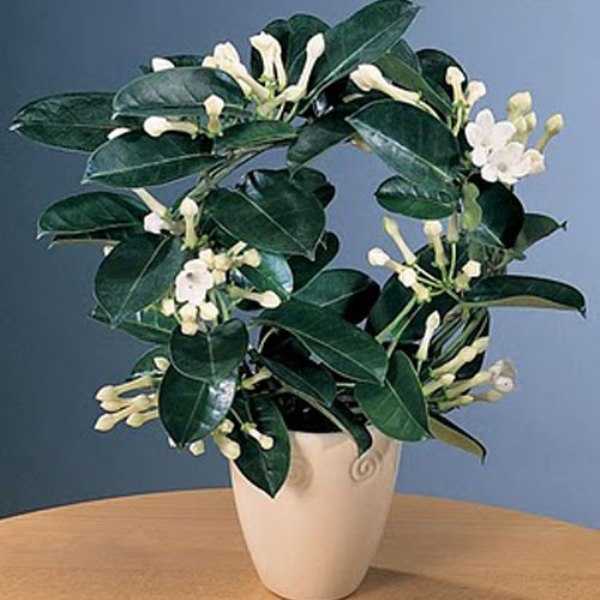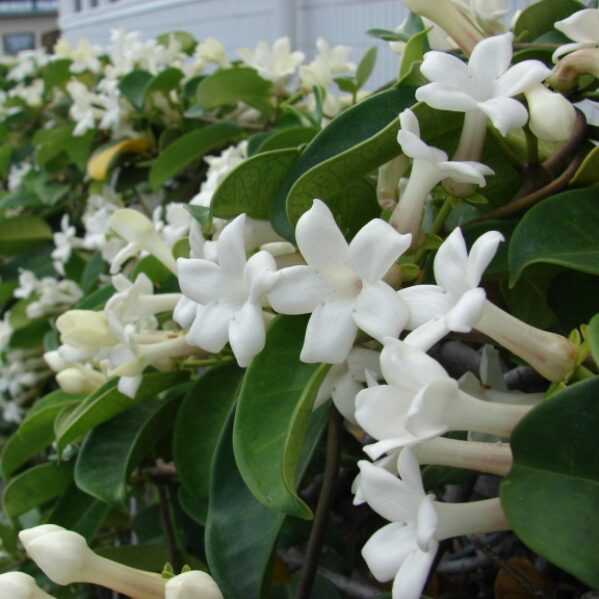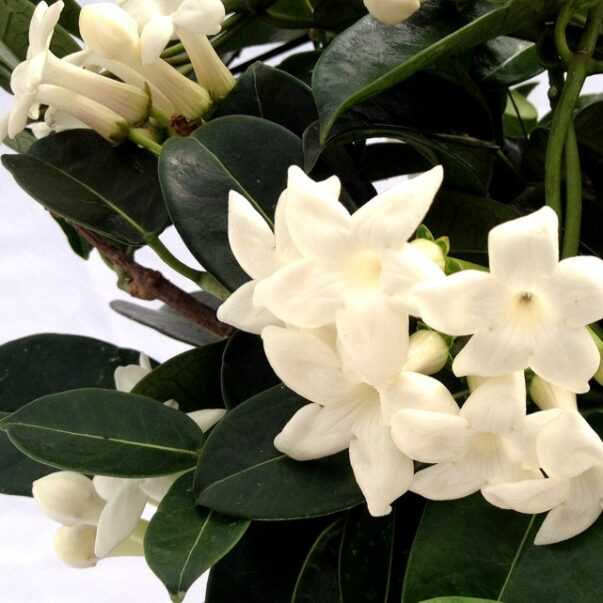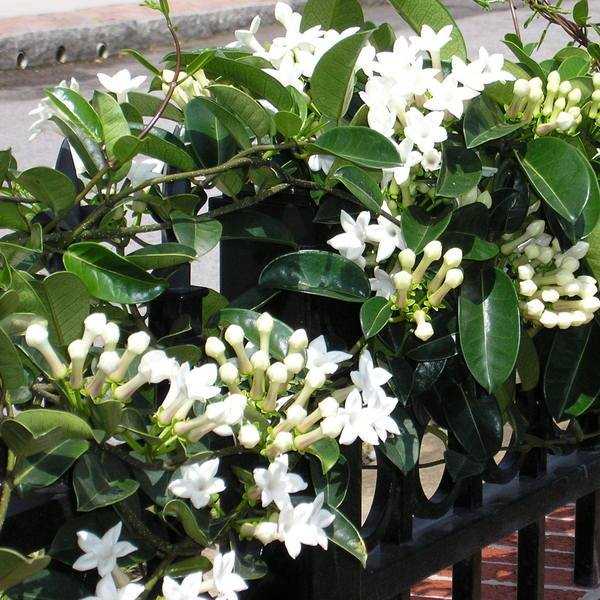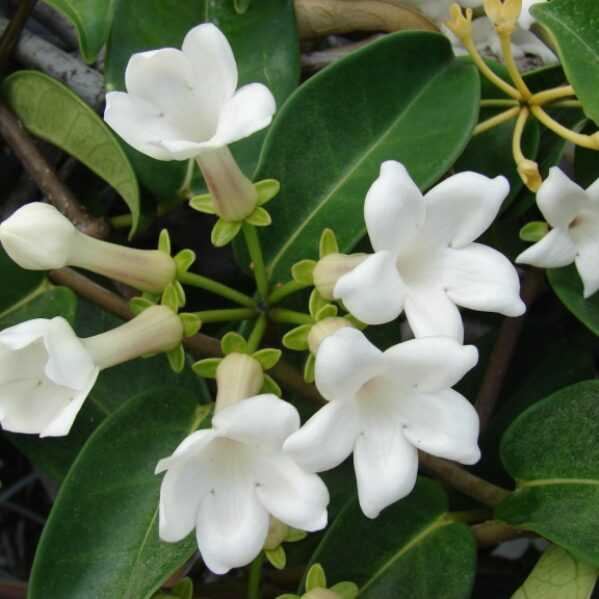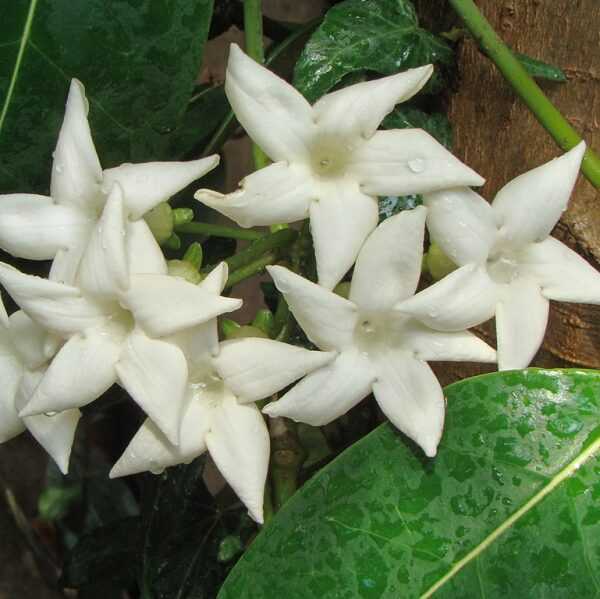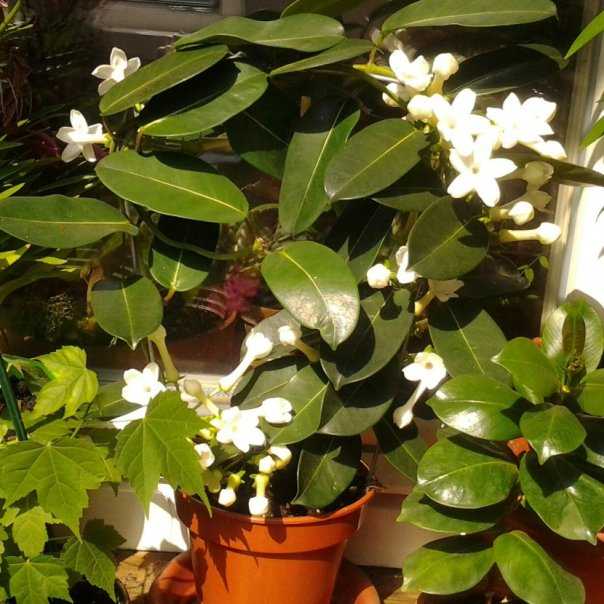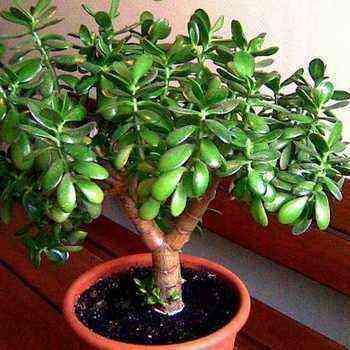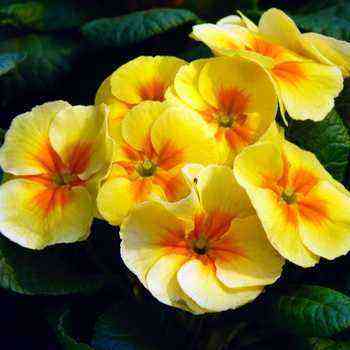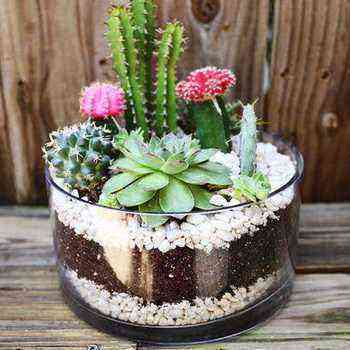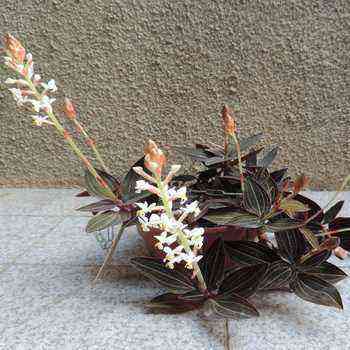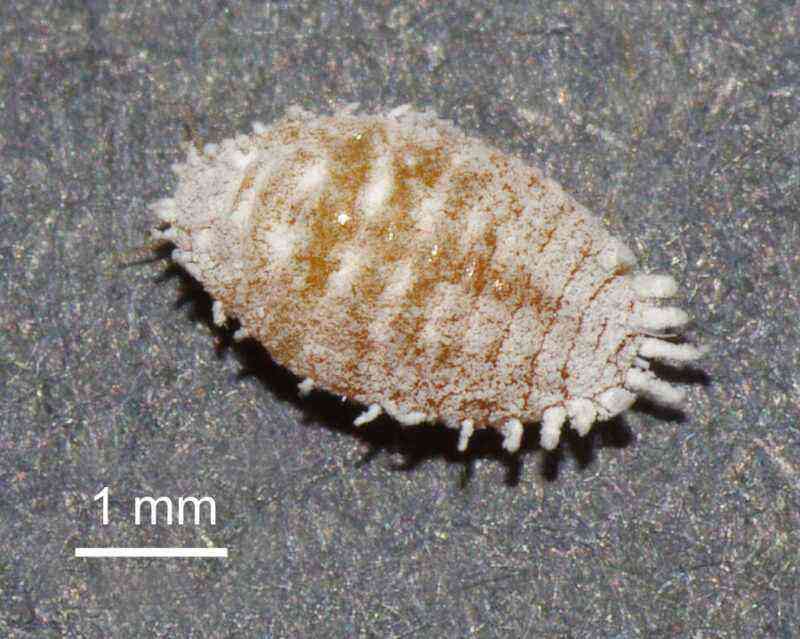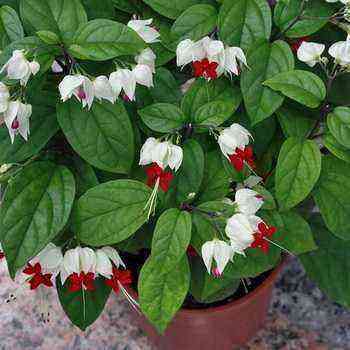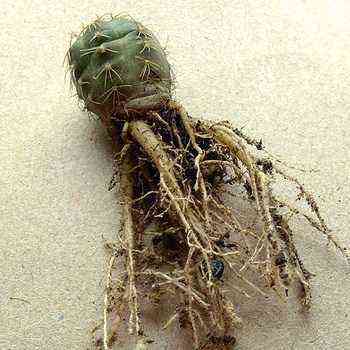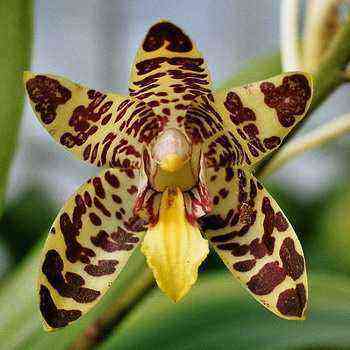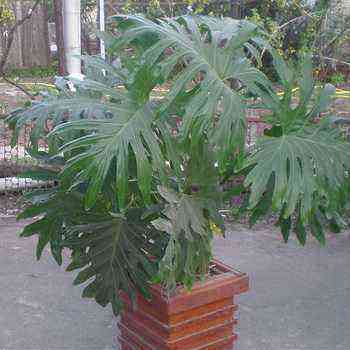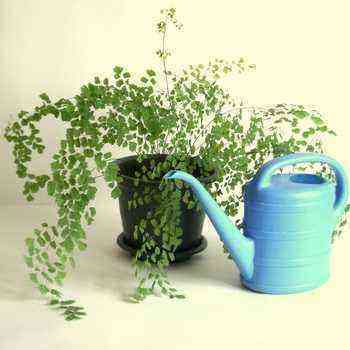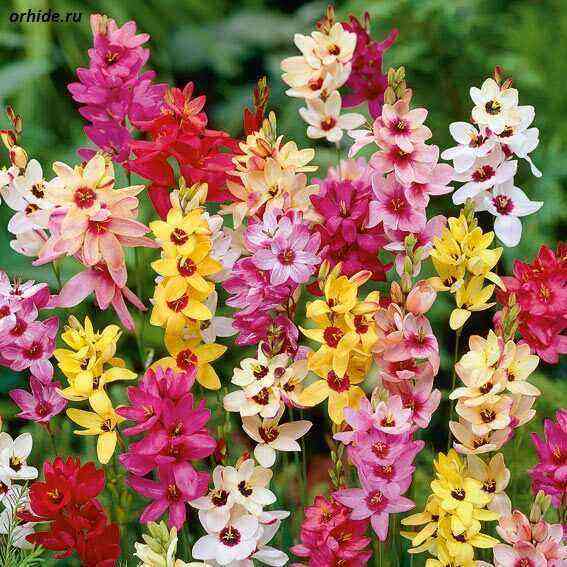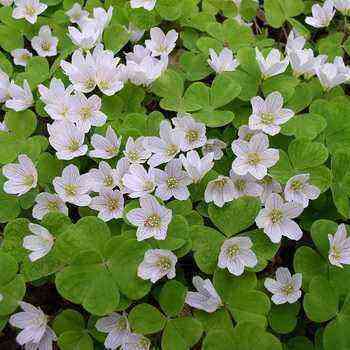Potted flowers stephanotis are a genus of flowering plants of the Apokinac family, genus Stefanotis. The plant takes its name from the Greek “Stephanotis” – the ear, the translation of which speaks of the arrangement of the stamens in the flower, presumably in the shape of an ear. By the way, this flower is also called Madagascar jasmine and it is also known as the “bride’s flower” or “veil vine”. The genus includes 10-15 species of evergreen, woody stems from tropical Africa, so it is best to grow them either indoors or in a greenhouse. They are grown for a strong aroma of waxy, tubular flowers usually white in color. The small white flowers are very reminiscent of jasmine. But, nevertheless, the flowers are in no way related to each other, since jasmine is part of the olive family. You can see in the photo of Stephanotis on this page numerous varieties and varieties:
Tropical climbing vines with lustrous foliage and fragrant snow-white Stephanotis flowers are a traditional element of wedding bouquets. In the language of flowers, Stefanotis symbolizes family harmony, moreover, it does not take up much space in a wedding bouquet.
Madagascar has introduced the world to many exotic species of flora and fauna, since the first Arab traders reached the shores of its shores in the seventh century AD. This flower is an important biological wealth of this tiny republic, which has no analogues in the world anywhere in the world. Unlike many of Madagascar’s endangered species, Stephanotis indoor flowers are available to any fan of exotic flowers, who, by the way, can repeat the tropical conditions for flower growth in their homeland. This should be taken into account when organizing care for Stephanotis at home, humidity and air temperature are important.
Fifteen species of evergreen are known, but only one species is grown as a houseplant – Stephanotis floribunda, also known as the waxed flower, which was first introduced in Madagascar in 1839.
Description of Stephanotis and his photo
As it grows, an evergreen shrub can grow up to 4,5 meters in height and usually branches in several directions. The stems can far exceed this growth, but the process can be controlled by periodically pruning and removing any growths around them. Stephanotis, judging by the description of botanists, is not the easiest plant to reproduce at home. But if there is a window where he can get enough light, then this will very well affect the flower. In the conditions of our region, it is best to grow it in a greenhouse or in a winter garden, where they will look as attractive as possible with elegantly hanging flowers.
You can see various photos of Stephanotis with different colors and colors of leaves:
White, waxy, tube-shaped flowers appear in star-like clusters on a peduncle or cluster of legs (a small group of trunks, each of which produces a flower attached to the stem). They can bloom any time of the year in an environment with ample light, warmth and humidity, although they bloom most often in spring and summer, especially outdoors.
Indoor flowers Stephanotis rarely do well in temperate regions indoors and outdoors. It is most likely to bloom if you provide it with a cool room during the winter (dormant period) and warm in summer and spring with above average humidity. You can often observe a picture – buds appear, and then fall off before or after the still closed flowers turn yellow. Moving them to a cold room can cause the flowers to fall off before full bloom.
To get a good result, with bright and beautiful flowers, you need to work long and hard – flowers do not always appear immediately.
The foliage on the Stephanotis vine blooms very well, even when there are some flowering problems, and most often they appear in pairs in opposite directions. During growth, they are large, even while the bush itself is small. The leaves are oval in shape and are up to 10 centimeters in length, and can be longer and have a glossy appearance. On the inside, it has the same attractive look.
The stems are thick and woody, but flexible enough to form a ball around the wires, which form a petiole behind the leaves.
When buying, pay attention to the appearance of Stephanotis – good, healthy green foliage. The bush has two or three clusters of buds, preferably with one or two flowers. Pay attention to whether the buds are fallen or not.
Some of the varieties have elongated fleshy fruits (especially during warm summers). It can reach 10 or even more centimeters long and have the shape of a pear (only they are not edible). The fruit will take several months to ripen, and if necessary, you can place them in a warm room to fully ripen. After the end of the process, they turn brown and begin to divide. At this stage, the two halves can be pulled apart to reveal a central mass of flattened seeds that have a silky train of white hairs attached to one end. In winter, seeds should be stored in a dry, ventilated area.
Home care stephanotis
Caring for stephanotis at home is not as easy as it might seem to an inexperienced grower who later complains about an unsatisfactory result. But if you provide the necessary conditions and have a little patience, you will end up with beautiful flowers, as if made from wax.
The flower vines are very thermophilic, so they can only grow outdoors in very warm climates. In the conditions of an apartment, the light can range from sunny places to partial shade. It just needs to be in a bright spot, but not in direct sunlight, which can damage the leaves. Consider this circumstance when organizing care for Stephanotis at home on your windowsill.
Madagascar jasmine will feel great in a well-ventilated room, but not in a draft, in a place free from gassed air.
From time to time, the leaves should be wiped with a damp cloth, but never use leaf polish on it. But it is necessary to water Stephanotis during home care every day, especially in summer and during the growing season (on hot days, the water should be cool). Water must be soft – either settled rain or bottled. No need to spray. To maintain constant moisture, you can place the pot on a saucer with wet pebbles.
Additional humidity in the summer when caring for Stephanotis at home should only be provided if the air is too dry. If possible, avoid dry air from artificial heating in winter.
Also, stephanotis indoor flowers need loamy soil that retains constant moisture, but you cannot leave them with damp roots (this can cause leaves to curl and die).
When pruning, the plants will cut any sparse growths in about half, if necessary. Also cut the side shoots by about 7 centimeters or so and cut out the weak shoots. It is best to carry out the procedure in the spring.
Stephanotis transplant
It is necessary to transplant the plant into a new pot in early spring – after the first pruning annually, and the old ones once every two years. Adult plants can be placed in pots 12-15 cm in diameter, but young plants that continue to develop and grow should be placed in larger pots, for example, with a diameter of 20-25 cm.if the plant is too old or difficult to move (that is, it is dangerous to replant ), then simply replace the topsoil in the pot or place in the bath with fresh mixture. The transplant of Stephanotis should be carried out during the rest period. An earlier transplant of Stephanotis can damage the root system and there will be no flowering next year.
Reproduction of Stephanotis
There are several ways to propagate Stephanotis, the most suitable of which is chosen by flower growers depending on the availability of suitable planting material at hand.
Reproduction of Stephanotis by cuttings ensures complete preservation of the genetic and decorative qualities of the parent bush. In the spring, collect cuttings that have grown in a year. Prepare a pot with different parts of peat and coarse sand (or perlite). Choose a scion with two pairs of healthy leaves and a growing point. Cut off the stefanotis stalk just below the second pair. The stalk should be prepared in advance by cutting from the stem just below the leaves. A low pair of leaves should be removed. Dip the cut surface in powder to stimulate root growth, then shake to remove excess. In the pot, make small holes in the sealant with a stick or pencil. Insert the cutting so that the end of the trunk is at the end of the hole and the leaves are flush with the potting mixture. After that, the container must be covered with a plastic bag supported by a wire. During the day, remove the lid for at least five minutes and do not allow the potting mixture to dry out. Keep the sprouts at a temperature of at least 18 ° C in bright light, out of direct sunlight. After three weeks, remove the plastic and when the cutting is well established, repot the pot again. this is how Stephanotis propagates by cuttings obtained from the parent bush.
Seed propagation of Stephanotis is the most laborious process that requires careful home care during the seedling growth phase. As mentioned earlier, some of the species may contain fruit with seeds. Reproduction in this way takes a very long time, and a lot of seeds are also required, since they are poorly fertilized. It also takes a lot of time to ripen and prepare the seeds for sowing, and then it is necessary to provide them with an optimally warm temperature for germination. Experts still advise using the first method, as it is faster and more efficient.
Stephanotis floribunda
Also called stephanotis flowering. It is one of the species of flowering plants in the family native to Madagascar. The height of the flower can reach two meters or even more. Stefanotis floribunda is an evergreen woody plant with glossy, leathery oval leaves and a cluster of snow-white, wax-like, fragrant tubular flowers.
Optimal conditions for the growth and development of Stephanotis Floribunda are created in the vastness of Madagascar – moderate temperatures, high humidity, seasonal hot cycles, wet and cool summers and dry winters. Provided there is enough moisture and water, it can bloom all year round and is a popular element in wedding bouquets.
Indoors with access to light, for example on a sunny windowsill, with proper home care for Stephanotis, they can bloom for a very long time. During summer, you can move the flower outdoors or in a greenhouse.
During the growing season, the plant requires full sun, plenty of water and high humidity. The amount of fertilizer should be balanced. You also need restraints, for example a trellis for a vine, as it tends to grow actively. As soon as the temperature outside begins to drop, Stephanotis should be immediately moved to a room in the sunniest place. If the apartment is cool, then the foliage will grow very slowly and it is worth watering occasionally in this case. During the winter, the flower may continue to grow, but very slowly and not as vigorously.
Stefanotis leaves turn yellow
Chlorosis from lime in water can cause yellowing of leaves. It can be cured by pouring water with a solution of absorbed iron, and then with plain water. Also, the reason may be the lack of the required amount of light – in this case, it is not difficult to solve the problem, you just need to move the stephanotis to a brighter place. There are other reasons why the leaves of Stephanotis turn yellow, consider some of them.
If the leaves turn yellow on the inside as well, it means that a red spider mite has grown on the leaves. It can be removed with a swab soaked in denatured alcohol. By the way, you should know that the plant will be more resistant to insect attacks if it is kept in a room with an optimal temperature in winter, that is, 18 degrees.
If the leaves of Stephanotis turn yellow and fall off, then the number and capacity of watering should be limited. This happens naturally with the lower leaves, but if it happens with two or more leaves, it is worth checking if you are watering it too much or if there have been temperature changes. Another possible cause is hard water. A similar cause can be easily corrected by rinsing with rain or bottled water.
Stefanotis does not bloom
Stefanotis will not flower if you may not have followed the care instructions exactly. Lack of light, heat or humidity may also be the reason. Another possible reason is that the flower was not provided with rest during the winter. It is no less rare that Stephanotis does not bloom in the absence of a sufficient amount of the necessary trace elements in the soil mixture. It is dangerous to overfeed the plant with nitrogen, which stimulates the formation of a large amount of green mass. The emerging flower buds are robbed, budding does not occur. To correct the situation, it is necessary to apply mineral fertilizers once a week with a predominance of the percentage of potassium and phosphorus. Feed 1 times with organic matter at intervals of 3 days.

